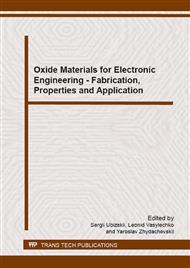p.184
p.193
p.199
p.205
p.211
p.217
p.221
p.228
p.233
Complex Impedance Analyses of Ba1-xLi0.5xBi0.5xTiO3 Solid Solution PTCR Ceramics
Abstract:
Conditions for the formation of (1-x)BaTiO3–xLi0.5Bi0.5TiO3 (0 ≤ x ≤0.6) solid solutions with positive temperature coefficient of resistance (PTCR) effect were studied. Solid solutions were prepared by solid state reaction technique. Samples were sintered under reducing atmosphere N2/H2 in the temperature range 1200–1450 °C with subsequent oxidation in air. The phase composition was investigated by X-ray powder diffraction method. It was found that samples of (1-x)BaTiO3–xLi0.5Bi0.5TiO3 (0 ≤ x ≤0.6) solid solutions at room temperature exhibit perovskite structure. Unit cell parameters of unstable at the room temperature compound Li0.5Bi0.5TiO3 were determined by extrapolation of concentration dependence of the unit cell parameters in the (1-x)BaTiO3–xLi0.5Bi0.5TiO3 system. It was shown that minimum value of resistivity ρmin rises with increase in x value. Complex impedance method shown that ceramic grains of (1-x)BaTiO3–xLi0.5Bi0.5TiO3 materials consist of three areas with different electrical properties. Boundary and outerlayer region of grains make the main contribution to the PTCR effect in lithium-containing solid solutions. It was shown that magnitude of the potential barrier's decreases with increasing x.
Info:
Periodical:
Pages:
211-216
Citation:
Online since:
June 2015
Authors:
Keywords:
Price:
Сopyright:
© 2015 Trans Tech Publications Ltd. All Rights Reserved
Share:
Citation:


